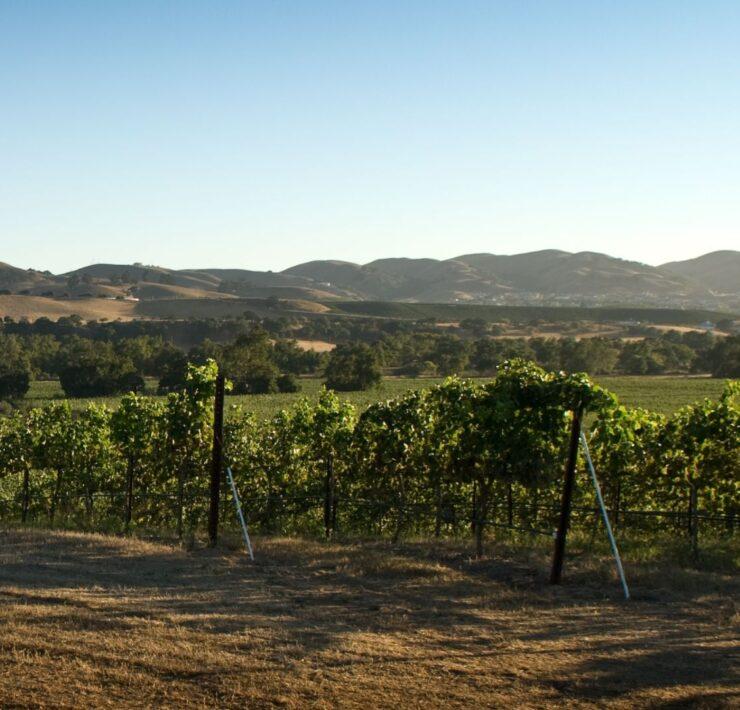Owning a vineyard in wine country is a faraway dream for many. Walking in the rolling hills amidst lush green vines and sweet-scented grapes is something one could potentially inherit in Italy or France. But in America, it often starts from the ground up, just like it did for Diane Carpenter and Ross Knoll Vineyard.
In 2016, the transition began, turning an old paddock in Sebastopol, California, into a 1.5-acre vineyard of Calera Clone Pinot Noir. The journey hasn’t been linear or easy, but it has been documented.
In a recent episode of Behind the Glass: Ross Knoll Vineyard, available exclusively to SOMM TV subscribers, cameras were there from day one. From the first stakes in the ground to samples from the barrels to 90+ point ratings, the result is a beautiful love story to terroir-driven Russian River Pinot Noir.
A Life-Changing Bottle
Twelve years before setting the first stakes in the ground, Carpenter had yet to set foot in the wine industry. “I was a stay-at-home mom for over 20 years…my whole life took a completely new path,” she says of her life-changing experience tasting a Napa Valley Cabernet Sauvignon in 2004. “I didn’t know wine could taste so good, and in that moment, I was hooked, wanting to learn everything there was to know about wine.”
That Cabernet was by winemaker Paul Hobbs, who Carpenter later went on to work for as a harvest intern for a handful of vintages beginning in 2011. “All of these young ladies I interned with were my daughter’s ages, and then there was me,” she says of the adventure. “I was completely outside of my comfort zone, yet it was one of the best decisions I ever made.”
Following studies through Wine & Spirit Education Trust, Carpenter purchased the future Ross Knoll Vineyard property in 2014, later partnering with viticulturist Scott Knippelmeir to transition the plot into a vineyard.

Turning Land Into an Organic Vineyard
A vineyard was not the plan in the early days of owning the property. But that intention changed after doing a soil analysis in 2015. “We have the perfect soil for Pinot Noir,” explains Carpenter in the Behind the Glass episode. “We have 85% Goldridge soil which is indigenous to the area, and 15% Sebastopol soil.”
Goldridge is a fine-grained sandy loam with excellent drainage. Sebastopol soils are also well draining according to the USDA — but are deep, having weathered from soft sandstone, with slopes ranging from 2 to 30%.
After obtaining the appropriate Sonomy County permits, work began laying pipe, pounding stakes, hanging wire, digging wells, and installing irrigation.
Before planting 3,000 Calera Clone vines, Carpenter considered the intention of the vineyard, prioritizing organic viticulture. “We started our cover crop in 2016; it was vibrant and unbelievable,” she says.
Cover crops typically increase biodiversity by improving soil health, enhancing water availability, smothering weeds, and helping control pests and diseases. “We had sweet pea, mustard, and fava beans, so (when that thrived), we knew that there was a lot of nutrition for the vines as well.”
The Pinot Noir plantings went into the ground in 2017, as did the gopher traps. Early on, traps gathered eight to 10 gophers daily, an expensive and ongoing problem. If left unchecked in a vineyard, the burrowing rodents gnaw on roots, leading to dead vines. They can also cause damage to irrigation systems and cause erosion by diverting water.
Instead of disposing of the animals caught in traps, the vineyard team ‘recycled’ them by taking them to a Sonoma animal rescue. “It’s horrible when you think about it,” says Carpenter, “but they went on to feed mountain lions and all sorts of rescue animals.”

Connecting Through Community
After planting the vines in 2017, fires hit the area hard. Flames threatened Ross Knoll Vineyard a mere 8 miles away, leading to a kismet connection. “That’s how Justin (Seidenfeld, consulting winemaker) entered our lives,” explains Carpenter. “His whole house burnt down. So he, his wife, his three little girls, their pet cat and his mom and dad, who also lived in the same neighborhood, all moved into my house.”
“She came to our rescue by letting us live on this amazing property for several months while we figured out our next steps,” says Seidenfeld.
While dealing with prudent life decisions following the fires, Seidenfeld and Carpenter gave equal importance to the early life of the vines. “Every time I gave her options of different paths we could go down, she picked the best path, regardless of difficulty and cost, as long as it was the best path, it was the path we went down,” Seidenfeld explains. “Not everybody does that. Many wine growers will say, ‘I just invested in this vineyard, and I want grapes faster’ — so they’ll cut a corner, and we didn’t do any of those things here.”

Winemaking According to Circumstance
The vines prospered in 2018 but were too young to produce a harvest. By 2019, there was enough fruit to pick for the inaugural rosé. But Mother Nature had different plans in 2020. “It was going to be our first vintage of Pinot Noir, but the smoke came in from Oregon, and we had to pick the fruit,” she explains. “That’s when we decided to make White Pinot fermented in stainless steel.” It was a quick decision that proved beneficial in the end. “It got 90 points!” exclaims Carpenter.

The roller coast of highs and lows continued, with a deep hit in 2021. “The whole vintage is going well, and suddenly there’s this frost that happens in early May destroying the whole vineyard, so we had to pivot,” says Carpenter. Her next call was to her first mentor, Paul Hobbs, asking to purchase fruit.
“So our first Pinot Noir in 2021 is mostly Clone 667 from Paul Hobbs, and the rest is Mount Eden Clone from Lynmar Estate, our custom crush facility,” she explains. Lynmar covered enough fruit to also make the 2021 White Pinot — this time fermenting in a neutral oak barrel. The result? A new mouthfeel and a 90-point rating from Wine Enthusiast. Hobbs was the source for the vintage’s rosé.
“One of the things that inspires me about Diane is her tenacity to power through any adversity that comes her way,” says Seidenfeld. “While it’s pretty common to deal with some of those (climate) challenges throughout a winemaking career, in five years, it’s unheard of.”
Fortunately, 2022 was a near-perfect vintage. “It was wonderful,” says Carpenter. “We got almost three tons out of the vineyard.”
Two Steps Forward…
Despite the challenges over the last seven years, Carpenter has found resiliency by finding like-minded people to work with and being humble. “You must be humbled because that’s the only way you’ll get through. You’ll fail a lot, and you have to accept it. It always feels like two steps forward, one step back.”
When sitting to taste the 2021 Pinot Noir in SOMM TV’s Behind the Glass episode, Carpenter is quick to draw parallels between the vines and her life. “It wasn’t just the vines which were growing; it was me as a person,” she continues. “I don’t recognize the person back then, today, and I don’t take any of this for granted. I feel blessed.”










